I have been, or can be if you click on a link and make a purchase, compensated via a cash payment, gift, or something else of value for writing this post. As an Amazon Associate, I earn from qualifying purchases. Please read my full Affiliate Disclosure for more information.
Imagine transforming a shared bedroom into a magical space where both boys and girls feel comfortable, inspired, and happy. Shared bedrooms are increasingly popular because they foster a sense of camaraderie and make the most of available space, all while allowing kids to express their unique personalities within a coordinated environment. It’s a fun challenge for parents and designers alike to create a harmonious balance that suits both genders and sparks joy.
In this article, you’ll discover a delightful array of ideas—from playful themes and clever storage solutions to personalized decor that celebrates individuality. Whether you’re looking for colorful, minimalist, or whimsical touches, these shared bedroom ideas will inspire you to craft a space that promotes friendship, comfort, and creativity for your little ones. Get ready to transform their room into a shared sanctuary they’ll love!
1. Dual-Color Wall Palettes for Balanced Vibes

Ever felt like your kids’ shared space is just a chaotic clash of styles and colors? Finding a way to make it feel balanced and harmonious can seem impossible, especially when personalities clash. The goal is to create a room that feels personal yet unified, without turning into a rainbow explosion. This idea helps blend individuality with a cohesive vibe.
Recommended Products to replicate this idea
| # | Preview | Product | |
|---|---|---|---|
| 1 |

|
Bates - Paint Tray Set, Paint Rollers, Paint Brushes for Wall, Tray, Roller Brush, 11 Piece Home... | Check Latest Price |
| # | Preview | Product | |
|---|---|---|---|
| 1 |

|
RoomMates Bluey Family and Friends Peel and Stick Wall Decals, RMK5457SCS | Check Latest Price |
Imagine dividing the wall with a subtle color split—perhaps a soft gray on one side and a gentle pastel on the other. The paint lines are crisp, but the overall palette stays soothing and not overwhelming. Textured wall finishes or matte paints add depth, while contrasting colors highlight personal zones. The room feels lively yet serene, with each side having its own character but still part of one space.
Choose neutral tones like creams and grays for a calming base or go bold with complementary shades like navy and mustard. For a more seasonal twist, swap out accent colors—bright in summer, muted in winter. You can also experiment with wallpaper on one side or painted murals to add personal flair. This approach scales well for small bedrooms or large shared spaces, making it flexible for any room size.
Start by selecting two harmonious color schemes that suit both children. Use painter’s tape to create a clean line down the wall, then carefully paint each side with high-quality, washable paint. Consider using different textures or finishes—matte, eggshell—to add subtle variation. Keep tools like level and straight edge handy for precise lines. To avoid touch-ups, tape off edges after the paint dries, then add a sealant if desired. The result is a balanced, visually appealing wall that visually separates personal zones.
Add personalized touches with custom decals, wall stickers, or subtle patterns that reflect each child’s interests. Consider using different textured wall coverings or fabric panels for tactile variety. You can also incorporate small shelving units or ledges to display favorite items without cluttering the space. Incorporate soft textiles like throws or cushions in each zone to reinforce personal comfort. These small details make the room feel uniquely theirs while maintaining harmony.
This color approach proves you don’t need a complete overhaul to make a shared space feel balanced. It’s easy to update with seasonal changes or new personal tastes. Plus, it creates a calming environment that fosters cooperation and respect. Ready to give your kids’ room a fresh, harmonious new look? It’s simpler than it seems and totally worth the effort!
2. Modular Bunk Beds with Personal Nooks

Sharing a bedroom often feels like a battle for space and privacy. Kids want their own zone but don’t want to sacrifice floor area or style. Modular bunk beds with built-in personal nooks solve this dilemma by maximizing vertical space. They give each child a designated area within the same room, reducing conflicts and clutter.
Recommended Products to replicate this idea
| # | Preview | Product | |
|---|---|---|---|
| 1 |

|
Rolanstar Metal Bunk Bed Twin Over Twin with USB Charging Station, LED Bunk Bed with 2 Storage... | Check Latest Price |
| # | Preview | Product | |
|---|---|---|---|
| 1 |

|
Kids Tent, Play Tent with Star Lights, Large Play Tents with 2 Windows, Kids Playhouse Indoor &... | Check Latest Price |
Picture a sturdy, sleek bunk bed with a cozy corner tucked underneath or beside it. Each nook is personalized with a small shelf, a soft cushion, or a fabric curtain that adds a sense of retreat. The beds are made of light wood or metal, with painted accents matching each child’s personality. The entire setup feels like a mini apartment within the bedroom, with each kid having their own private zone for sleeping, reading, or relaxing.
Opt for different configurations—side-by-side, L-shaped, or with a loft design—to suit your space. Customize each nook with themed fabrics, fairy lights, or wall-mounted storage for books and toys. For smaller rooms, go for space-saving designs like fold-out beds or beds with integrated desks. Seasonal decor can be added with removable textiles or decorative cushions, making each nook feel fresh and personalized.
Start by measuring your space and choosing modular beds that fit comfortably. Look for options with integrated shelves, drawers, or mini desks to maximize utility. Assemble the beds following manufacturer instructions, ensuring safety features like guard rails are secure. Decorate each nook with removable textiles, posters, or small storage baskets tailored to each child’s taste. For added privacy, install fabric curtains or partial panels. Regular cleaning and reorganization keep these zones functional and inviting.
Let each child choose their bedding, cushions, and decorative accents—like themed posters or plush toys—within their nook. Incorporate lighting options like clip-on lamps or small LED strips that don’t need electrical wiring. Use wall-mounted hooks or pegboards for organizing personal items. You can also add a small chalkboard or whiteboard inside each nook for doodles or notes. This turns each space into a true sanctuary that feels personal.
These modular bunk beds turn a shared bedroom into a multi-functional space that respects individuality. They make clean-up easier and promote independence as kids learn to organize their personal zones. Plus, they’re a fun way to design a space that grows with your children. Ready to transform your bedroom into a smart, personalized haven? It’s a practical and stylish upgrade you’ll love!
3. Customized Storage Solutions for Clutter-Free Fun

Does clutter take over your kids’ room faster than you can say ‘tidy’? Keeping toys, books, and clothes organized can feel like a losing battle. Customized storage solutions make it easier to keep everything in its place without sacrificing style. They turn chaos into calm and give kids a sense of responsibility.
Recommended Products to replicate this idea
| # | Preview | Product | |
|---|---|---|---|
| 1 |

|
Sterilite 6-Pack Industrial Tote, Plastic Storage Container Bins with Lids, 27 Gallon - Heavy-Duty... | Check Latest Price |
| # | Preview | Product | |
|---|---|---|---|
| 1 |

|
BAYKA Floating Shelves for Wall, Wall Mounted Rustic Wood Shelves for Bathroom, Bedroom, Living... | Check Latest Price |
Imagine open cubbies painted in bright, cheerful colors with labeled bins for toys and art supplies. Under-bed drawers slide out smoothly to hide away seasonal clothing or extra bedding. Wall-mounted shelves hold personal collections or favorite books, keeping them accessible yet tidy. The room feels airy and organized, with everything having its designated spot, making clean-up a breeze and reducing stress.
Choose gender-neutral options like woven baskets, clear plastic bins, or fabric totes for versatility. Install modular shelving units that can grow with your children’s needs. For small rooms, utilize vertical space with wall-mounted storage or over-the-door organizers. Seasonal or special occasion storage can be hidden in decorative boxes or labeled containers, keeping the room clutter-free year-round.
Start by assessing what items need the most organization—toys, clothes, school supplies. Look for multi-purpose furniture like beds with built-in drawers or storage ottomans. Install adjustable shelving and hooks at different heights to accommodate growth and changing needs. Use clear bins or labeled containers for easy identification. Keep frequently used items within reach, and store seasonal or rarely used items higher or in less accessible spots. Regular tidying keeps the system functional.
Incorporate personalized labels or decals on bins and shelves to encourage kids to put things away. Use decorative storage baskets that match the room’s color scheme or theme. Add small, portable caddies for art supplies or homework essentials. Consider rotating storage styles seasonally or as interests change, keeping the space fresh and engaging for everyone involved.
Smart storage solutions turn messy rooms into organized havens, making daily routines smoother. Kids learn responsibility by tidying up their personal belongings, fostering independence. It’s a practical way to teach organization skills early on. Ready to ditch clutter and boost your child’s confidence? These tailored storage ideas are your new best friend!
4. Themed Accent Walls for Personal Expression
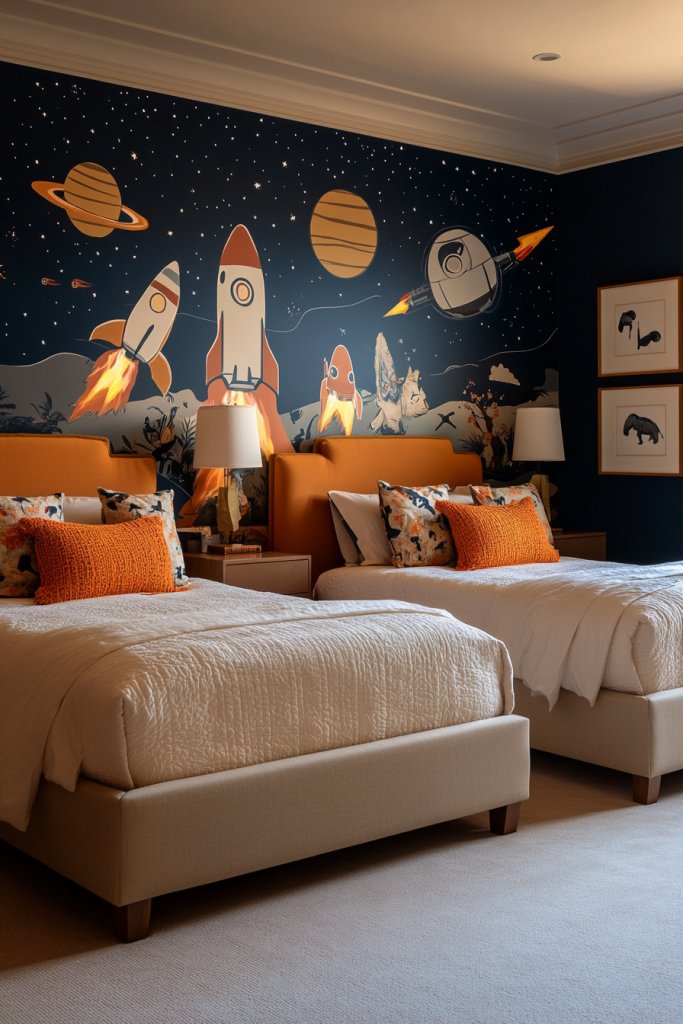
Tired of plain walls that do nothing to reflect your kids’ personalities? A themed accent wall adds a splash of character and makes the room feel special. It’s a simple way to showcase interests without overwhelming the space or cluttering the decor. Plus, it’s an easy update as tastes evolve.
Recommended Products to replicate this idea
| # | Preview | Product | |
|---|---|---|---|
| 1 |

|
Art3d Smoothing Tool Kit for Applying Peel and Stick Wallpaper, Vinyl Backsplash Tile | Check Latest Price |
| # | Preview | Product | |
|---|---|---|---|
| 1 |

|
RoomMates Bluey Family and Friends Peel and Stick Wall Decals, RMK5457SCS | Check Latest Price |
Picture a wall painted with a subtle galaxy scene or a soft watercolor landscape. Textured wallpaper with stars, animals, or abstract patterns creates visual interest without taking over. Use removable decals or stencils for DIY designs that can be changed easily. The wall becomes a focal point, inspiring imagination and conversation while complementing the room’s overall color scheme.
Themes can range from nature-inspired murals to fun comic book motifs or playful geometric patterns. For a versatile look, choose washable paints or peel-and-stick wallpapers that are easy to remove. Seasonal themes like ocean waves or autumn leaves can be swapped out periodically. This approach suits various ages and interests, from toddlers to teens.
Begin by selecting a theme that matches your child’s interests. Prep the wall with clean, smooth surfaces—sanding and priming if necessary. Use painter’s tape for clean borders or geometric shapes. Apply high-quality, washable paints or peel-and-stick wallpaper for easy removal later. Add complementary decor like themed bedding or accessories that tie the look together. Keep the design simple to avoid visual overload and ensure easy maintenance.
Encourage your kids to participate in designing their accent wall with drawings, stencils, or choosing colors. Add framed fabric panels, decorative wall decals, or fabric borders for texture. Incorporate favorite characters or motifs that evolve over time, making the wall a reflection of their current passions. This personal touch keeps the room feeling fresh and engaging.
A themed accent wall boosts a child’s sense of ownership and pride in their space. It’s an affordable way to create a big impact without remodeling. Plus, it offers a perfect backdrop for photo memories or showcasing new interests. Ready to turn a blank wall into a personal masterpiece? Your kids will love showing it off!
5. Shared Desk Area with Divided Workspaces

Sharing a desk can quickly turn into a battleground for space and concentration. Kids need a dedicated spot to do homework, crafts, or creative projects without stepping on each other’s toes. Creating a divided workspace encourages focus and independence while fostering cooperation. It’s a practical fix for a common sibling challenge.
Recommended Products to replicate this idea
| # | Preview | Product | |
|---|---|---|---|
| 1 |

|
Multiuse Caddy Organizer with Handle - Stackable Plastic Tote Bin - Art Craft Supplies, Office,... | Check Latest Price |
| # | Preview | Product | |
|---|---|---|---|
| 1 |

|
Marbrasse Expandable Desk Drawer Organizer, Mesh Drawer Organizer Tray with 10 Adjustable... | Check Latest Price |
Imagine a large, sturdy desk with a painted or vinyl-lined dividing line down the middle. Each side has its own set of organizers—pens, notebooks, and art supplies—matching each child’s style. Bright desk mats, colorful containers, and a few personal touches differentiate the zones. The shared space feels open yet personal, with clear boundaries that prevent conflicts and promote productivity.
Use painted lines, decals, or even removable tape to mark the division. For smaller rooms, opt for compact desks with built-in storage or fold-out features. Personalize each side with different color schemes or themed accessories. Seasonal or project-based swaps keep the area fresh, and adjustable dividers can grow with your kids’ changing needs.
Measure your space carefully and select a sturdy, spacious desk suitable for two. Use painter’s tape or washi tape to create a clear division, then paint or decorate the line for added visual interest. Organize each side with matching storage bins, pencil cups, and small shelves. Add task lighting like clip-on lamps to avoid sharing a single light source. Encourage your kids to keep their zones tidy by establishing routines, and regularly rotate supplies to keep the space engaging.
Let each child choose their favorite colors, patterns, or themes for their side of the desk. Add motivational posters, small plants, or decorative containers that reflect their personality. Incorporate different textures—soft fabrics, smooth plastics—to create tactile variety. You could also add a small corkboard or magnetic board for reminders, doodles, or inspiring quotes.
A divided shared workspace teaches kids about boundaries and respect while promoting independence. It reduces clutter and saves space, making homework and projects less stressful. Plus, it’s a simple way to make shared rooms feel more organized and less chaotic. Ready to give your kids a dedicated, personalized work zone? It’s a game-changer!
6. Coordinated Bedding with Unique Personal Touches
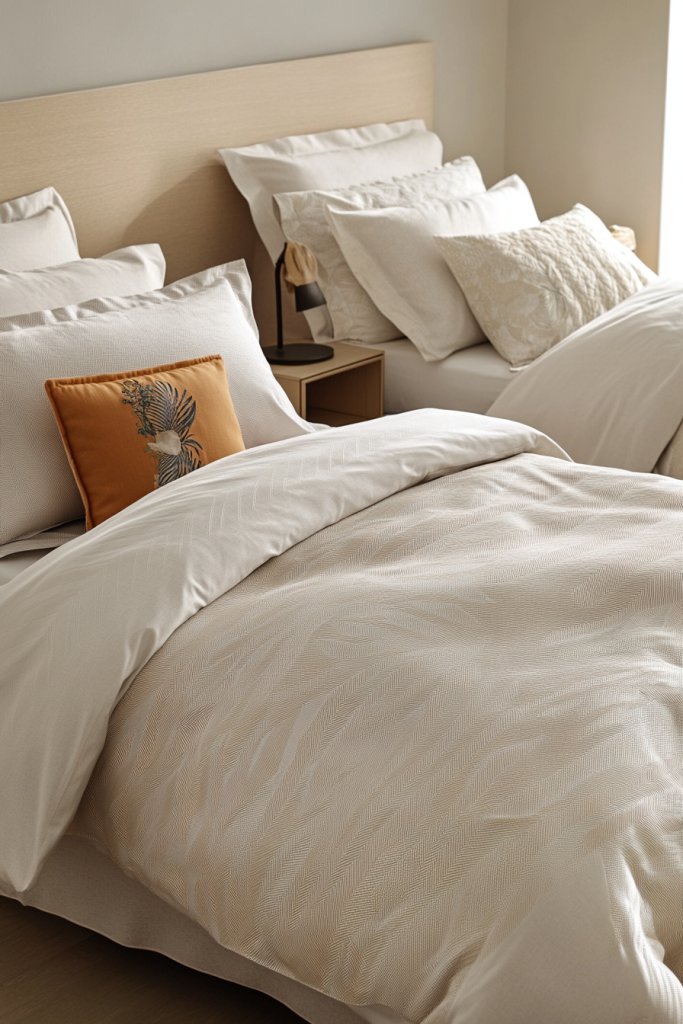
Matching bedding can unify a shared bedroom but often feels boring or impersonal. Kids crave their own style, even within a coordinated look. Finding a balance between harmony and individuality can be tricky. This idea lets you create a cohesive aesthetic with space for personal expression.
Recommended Products to replicate this idea
| # | Preview | Product | |
|---|---|---|---|
| 1 |

|
Bedsure White Duvet Cover Queen Size - 3 Pieces Prewashed Extra Soft Bedding Set, Includes 1 Duvet... | Check Latest Price |
| # | Preview | Product | |
|---|---|---|---|
| 1 |

|
Kokaaee Decorative Throw Pillow Cover 18x18 - Vintage Pillowcovers with Fringe Bird Flower Cute... | Check Latest Price |
Visualize matching duvet covers in neutral tones with each child adding their own flair through pillows or throws. Maybe one prefers a playful animal print, while the other loves geometric shapes. The bedding sets coordinate through colors or patterns but include personal accents like embroidered initials or themed cushions. The room feels unified yet personalized, with each child’s personality shining through.
Opt for neutral base sets and layer with different textured throws or pillowcases. Incorporate seasonal or special occasion accents like festive pillow covers or themed bedding sets. Use personalized pillowcases or labels for each child if needed. For older kids, opt for sleek, minimalist bedding with subtle patterns, adding personal accessories for character.
Choose bedding in complementary colors or matching sets with a durable, easy-care fabric. Mix and match pillows, throws, and blankets to create visual interest and comfort. Add decorative elements like textured cushions or embroidered initials. Layer different fabrics and patterns within a color palette to keep it lively yet harmonious. Wash and rotate bedding regularly to maintain freshness. Encourage kids to select their favorite pieces to foster ownership.
Let kids pick their favorite colors or themes for their pillows and throws. Add personal touches like embroidered names or patches. Mix textures—soft knits, smooth satins, or faux fur—to create tactile interest. Use decorative trims or piping for a finished look that reflects their style. Seasonal updates keep the bedding feeling new and exciting.
Coordinated bedding with personal touches enhances the room’s unity while celebrating individuality. It’s a simple way to boost confidence, allowing kids to feel their space is uniquely theirs. Plus, it’s practical—easy to wash, rotate, and update as tastes change. Ready to upgrade your bedding game? Your kids will thank you!
7. Playful Floor Zones with Area Rugs
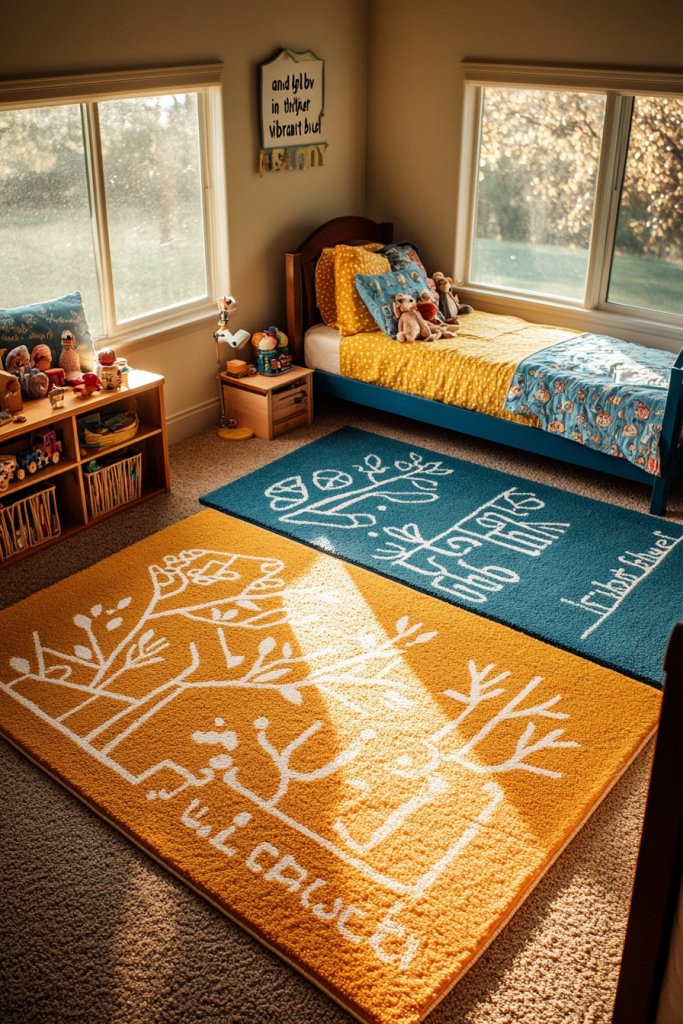
A shared bedroom can quickly turn into a chaotic mess, especially on the floor. Kids need designated zones for play, reading, or relaxing without disrupting each other. Using colorful, durable area rugs helps define these spaces clearly and adds a fun element to the room. It makes cleanup easier and the room more inviting.
Recommended Products to replicate this idea
| # | Preview | Product | |
|---|---|---|---|
| 1 |

|
Srugn Washable Rugs 8x10 Area Rugs for Living Room,Ultra Soft Faux Wool Retro Rugs for... | Check Latest Price |
| # | Preview | Product | |
|---|---|---|---|
| 1 |

|
GORILLA GRIP Strong Rug Pad Gripper, US Designed, Grips Help Keep Area Rugs Safe and in Place, Slip... | Check Latest Price |
Picture a large, plush rug with a vibrant pattern—perhaps a cityscape, a jungle scene, or geometric shapes—that anchors the play area. Surrounding it, a softer, neutral rug covers the reading nook or relaxation space. Textured rugs in playful shapes or bright colors add visual interest and tactile comfort. The room becomes a lively, multi-zone environment where each activity has its own space, and the floors look intentionally styled.
Choose rugs in washable, stain-resistant materials suitable for active kids. Layer rugs for a dynamic look or opt for one large statement piece. Seasonal or theme-based rugs can be swapped out to match interests or decor updates. Small rugs with fun patterns work well for cozy reading nooks, while larger ones define active play zones.
Measure your space to select appropriately sized rugs that fit comfortably without overcrowding. Opt for durable, easy-care materials like nylon or polypropylene. Place rugs in high-traffic areas, ensuring they’re securely anchored to prevent slipping. Use contrasting colors to delineate different zones clearly. Regular vacuuming and spot cleaning keep rugs fresh and inviting. Consider adding non-slip pads underneath for safety.
Coordinate rugs with the room’s color palette or theme, adding personal touches through custom patterns or motifs. Incorporate small plush or textured rugs for tactile variety. You can also add a few decorative cushions or bean bags nearby to enhance comfort. Seasonal throws or decorative borders further personalize each zone. It’s all about making each space feel fun and functional.
Designing playful floor zones encourages kids to take ownership of their space and keeps clutter off furniture and beds. It makes the room feel more organized and purposeful. Plus, colorful rugs add a cheerful vibe that lifts everyone’s mood. Ready to redefine your kid’s room with fun, functional zones? It’s a simple upgrade that pays off big!
8. Adjustable Lighting for Flexibility and Comfort
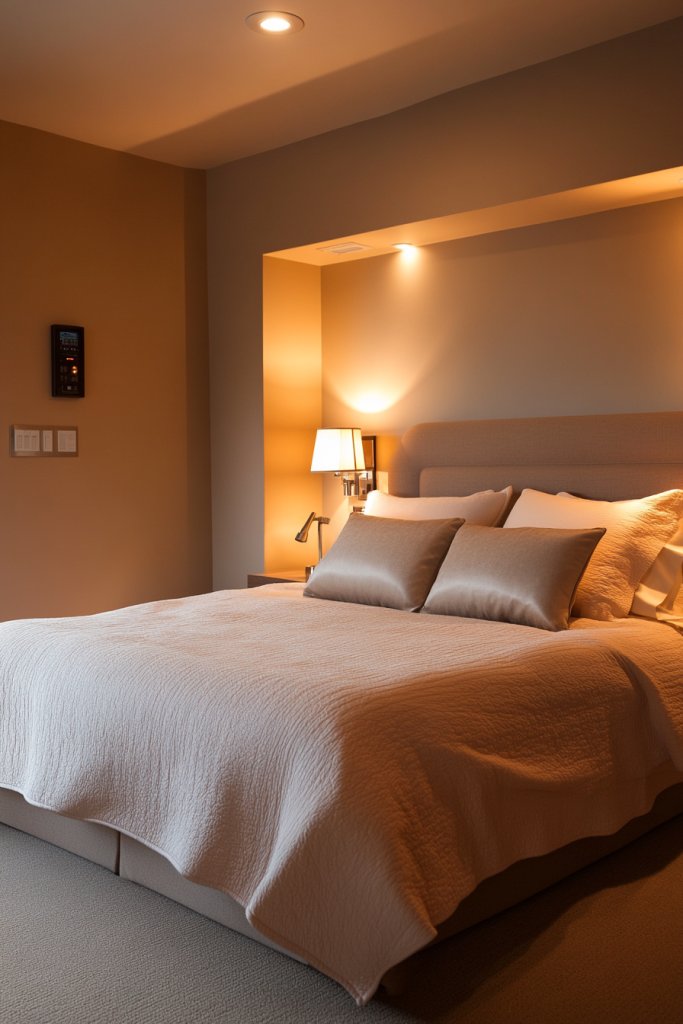
Lighting in a shared bedroom often feels like an afterthought—either too harsh or too dim. Kids need adjustable lighting to suit different activities like reading, studying, or winding down. Proper layered lighting creates a cozy environment and reduces conflicts over brightness. It’s about giving everyone control over their space.
Recommended Products to replicate this idea
| # | Preview | Product | |
|---|---|---|---|
| 1 |

|
hepside 12Inch Flush Mount Light Fixture White, 28Watt, Dimmable & 3000K-4500K-6000K 3 Color... | Check Latest Price |
| # | Preview | Product | |
|---|---|---|---|
| 1 |

|
Govee RGBIC LED Strip Lights, Smart LED Lights for Bedroom, Bluetooth LED Lights APP Control, DIY... | Check Latest Price |
Imagine a room with a central ceiling fixture, complemented by flexible wall sconces and clip-on reading lights. Soft, warm LED strips are tucked behind shelves or under bed frames, providing gentle ambient glow. During homework time, bright task lighting illuminates each child’s workspace. The layered lighting setup transforms the room into a versatile, cozy haven where every activity has its perfect light level.
Choose dimmable fixtures to adjust brightness easily. Incorporate smart lighting options that can be controlled via apps or voice commands for tech-savvy kids. Use decorative sconces or clip-on lamps that can be moved around as needed. Incorporate different color temperatures for mood—warm for relaxing, cool for studying. Seasonal lighting updates, like fairy lights during holidays, add a festive touch.
Start with a central ceiling fixture and add layered lighting options. Install dimmer switches to control overall brightness. Use adjustable wall sconces or clip-on lamps at each child’s desk or bed. Consider battery-operated LED strips for easy installation and flexibility. Test different placement options to ensure even, glare-free illumination. Regularly clean fixtures and replace bulbs to maintain optimal lighting quality.
Let kids choose their preferred lighting styles or colors—like colored bulbs or themed fixtures. Incorporate motion sensors or remote controls for convenience. Use soft, decorative lamps or lanterns as accent lighting to create a relaxing atmosphere. Encourage them to personalize their lighting zones with stickers or decals that match their room’s theme. The goal is a flexible, inviting environment tailored to their needs.
Layered, adjustable lighting makes daily routines smoother and more enjoyable. Kids learn to control their environment, fostering independence. It’s a simple way to improve room functionality and mood. Ready to upgrade your lighting game? Your kids will love having a space that adapts perfectly to every mood and activity.
9. Vertical Storage Walls to Maximize Space
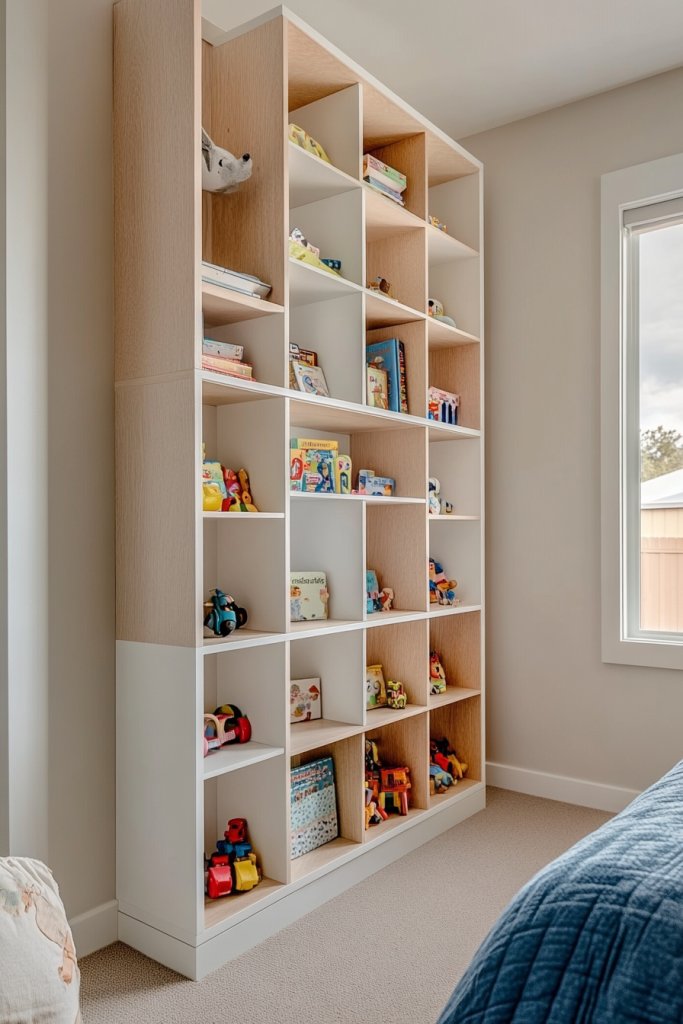
Does your kid’s room feel cluttered no matter how many bins you buy? Wall space often goes underutilized, wasting valuable storage opportunities. Vertical storage walls turn blank walls into organized, functional art pieces. They free up floor space and make everything easily accessible—no more digging through piles for that one toy or book.
Recommended Products to replicate this idea
| # | Preview | Product | |
|---|---|---|---|
| 1 |

|
FLEXIMOUNTS 2-Pack 2x6ft Garage Shelving 24-inch-by-72-inch Wall Shelf Garage Storage Rack Floating... | Check Latest Price |
| # | Preview | Product | |
|---|---|---|---|
| 1 |

|
Sterilite 6-Pack Industrial Tote, Plastic Storage Container Bins with Lids, 27 Gallon - Heavy-Duty... | Check Latest Price |
Picture a sleek wall lined with open shelves holding colorful bins, baskets, and neatly arranged books. Hooks and cubbies are mounted at different heights for toys, backpacks, and hats. The textured wall behind features a chalkboard or corkboard for doodles and notes. The entire wall becomes a vibrant, organized display that adds character while providing ample storage.
Use a mix of open shelves, closed cabinets, and hooks to suit your needs. Choose materials like wood, metal, or plastic based on your decor style and budget. Incorporate decorative bins, baskets, or fabric organizers that match the room’s theme. For small rooms, vertical wall units with multiple tiers maximize storage without sacrificing style. Seasonal or interest-based accessories can refresh the look periodically.
Start by assessing what needs storing—books, toys, accessories. Mount sturdy wall brackets and install shelves at varying heights for easy reach. Use labeled baskets or bins for better organization. For added versatility, incorporate hooks for hanging items or small pegboards for tools and craft supplies. Keep heavier items lower for safety, and ensure all hardware is securely anchored. Regular tidying keeps the space looking neat and inviting.
Decorate shelves with themed containers or colorful labels. Let kids add their own touches—like hanging their favorite hats or displaying their art in frames. Incorporate decorative elements like string lights or small sculptures on the shelves for visual interest. Adapt the storage system as interests change, so the wall stays fresh and relevant. It’s a dynamic setup that grows with your child.
Vertical storage walls turn clutter into a showcase, boosting confidence in a tidy space. Kids learn to organize their belongings independently, fostering responsibility. It also makes cleaning quicker and easier, freeing up more playtime. Ready to elevate your room’s function and style? A vertical wall is the way to go!
10. Personal Corner Nooks for Privacy and Comfort
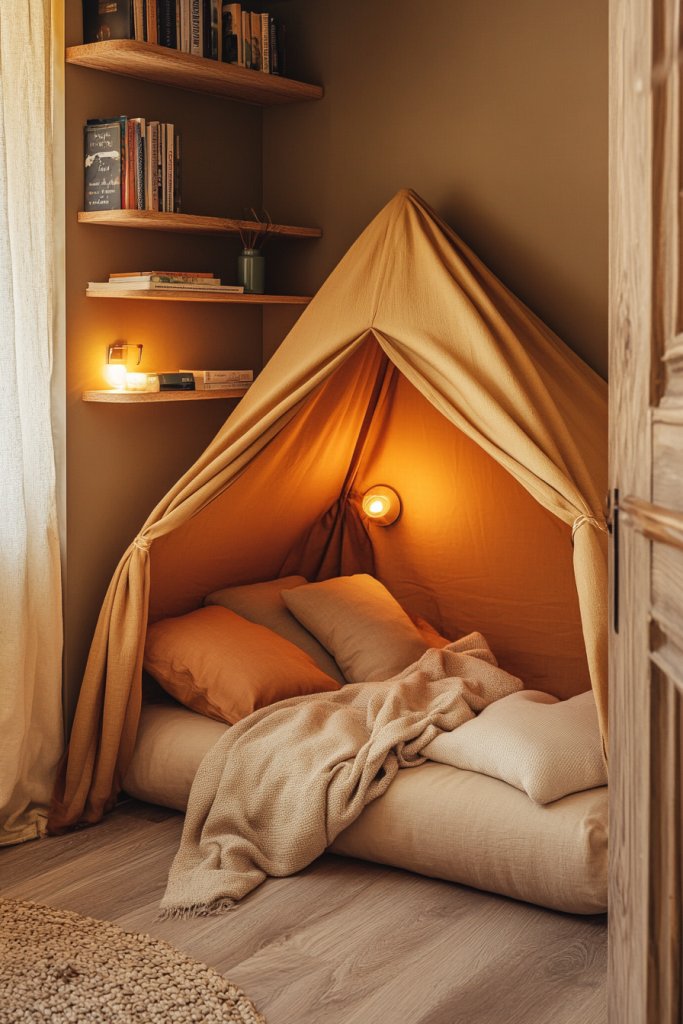
Sometimes, sharing a room feels more like sharing a circus act than a cozy space. Kids need a quiet corner to escape, read, or just think without interruptions. Creating personal nook retreats addresses this need for privacy and helps foster independence. It’s a small upgrade with big emotional benefits.
Recommended Products to replicate this idea
| # | Preview | Product | |
|---|---|---|---|
| 1 |

|
MAXYOYO Kids Bean Bag Chair, Stuffed Toddler Bean Bag Sofa with Filler Bean Bag Chair for Boys and... | Check Latest Price |
| # | Preview | Product | |
|---|---|---|---|
| 1 |

|
6 Pack Fairy Lights Battery Operated 7ft 20 LED Mini String Lights Twinkle Lights Silver Wire... | Check Latest Price |
Visualize a cozy corner tucked into a corner of the room, with a soft cushion or bean bag, a little tent, or a canopy for added privacy. Surround it with plush pillows, fairy lights (hidden behind fabric or discreet fixtures), and a small shelf for books or favorite toys. The space feels inviting and safe—a tiny sanctuary where kids can unwind or get lost in their imagination. It’s a perfect personal hideaway in a shared bedroom.
Use different themes like a fairy-tale tent, a spaceship capsule, or a jungle hideout to match your child’s interests. Decorate with soft textiles, like fleece blankets or cozy cushions, for tactile comfort. Incorporate removable fabric panels or curtains for easy access and privacy. This concept can be scaled for small corners or large alcoves, making it adaptable to any room size or style.
Choose a corner that’s quiet and away from high-traffic zones. Add a small, comfortable seat—like a bean bag or floor cushion—and surround it with soft textiles. Use lightweight fabrics or curtains to create a semi-enclosed space that’s easy to open and close. Install small wall-mounted shelves or pockets for personal belongings. Add string lights or portable lamps for ambiance. Encourage kids to personalize their nook with favorite toys or decorations.
Let children pick their theme, colors, and textiles to make it truly theirs. Add personal touches like their favorite stuffed animals, framed photos, or themed accessories. Incorporate tactile elements like fluffy rugs or textured cushions to make the space cozy. Rotate decor seasonally or as interests change, keeping the nook fresh and exciting. It’s their special spot for quiet moments.
A personal corner nook fosters independence and a sense of ownership. Kids learn to respect their space and enjoy having a quiet retreat. It’s a simple yet effective way to promote emotional well-being and creativity. Want a little private oasis in your shared room? It’s easier than you think and totally worth it!
11. Gender-Neutral Color Schemes for Versatility
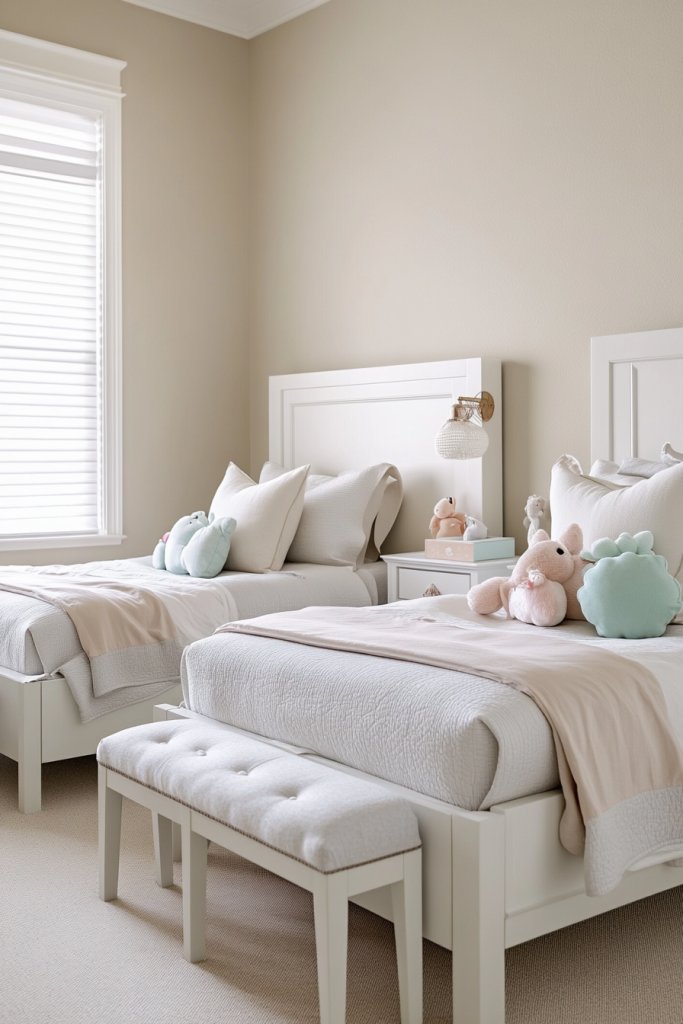
Choosing a color scheme for a shared bedroom can feel like walking a tightrope—pick wrong, and someone’s left feeling overshadowed or bored. Gender-neutral palettes offer a versatile solution that appeals to both boys and girls. They set a calm, stylish tone while allowing personal touches to shine through. It’s a practical way to create a balanced environment.
Recommended Products to replicate this idea
| # | Preview | Product | |
|---|---|---|---|
| 1 |

|
Glidden Total Interior Wall Paint & Primer All-in-One, Discover/Beige, Eggshell, 1 Gallon | Check Latest Price |
| # | Preview | Product | |
|---|---|---|---|
| 1 |

|
Layered Textiles: New Surfaces with Heat Tools, Machine and Hand Stitch | Check Latest Price |
Imagine walls painted in soft shades like pale gray, warm beige, or gentle pastels. Layer the room with textiles—blankets, cushions, curtains—in coordinated neutral tones with pops of color through accessories. The overall look is calm, sophisticated, and adaptable, with elements that can be easily swapped out as tastes change. This neutral backdrop makes personalization simple and effortless.
Use earthy tones like taupe, blush, or mint for a soothing vibe. Combine with natural materials like wood, jute, or cotton for added texture. Seasonal accents—like colorful throws or themed decor—can be added without disrupting the base palette. For a more vibrant look, incorporate bold accessories like pillows or rugs in complementary shades. It’s flexible enough to suit any age or style.
Select wall colors in matte or eggshell finishes for a soft, non-reflective surface. Use layered textiles to add tactile warmth and visual interest. Incorporate furniture in natural or painted finishes that blend seamlessly with the color scheme. Keep accessories minimal but impactful—think textured baskets, subtle prints, and simple lighting. Regularly update small decor items to keep the look fresh and inviting. The key is maintaining a calm, balanced foundation.
Add personality with personalized textiles—like monogrammed pillows or custom curtains. Incorporate decorative elements like textured wall panels or soft rugs. Kids can choose their favorite colors within the palette for their accessories. Use removable decals or wall stickers for a quick style update. The overall design remains versatile and timeless, allowing each child to add their personal touch.
A gender-neutral room provides a calm, inclusive space that grows with your kids. It encourages cooperation and shared ownership. The simple palette makes decorating and updating easier over time. Ready to create a versatile, stylish haven for your children? It’s a smart, timeless choice that pays off!
12. Creative Headboard Ideas for Visual Interest
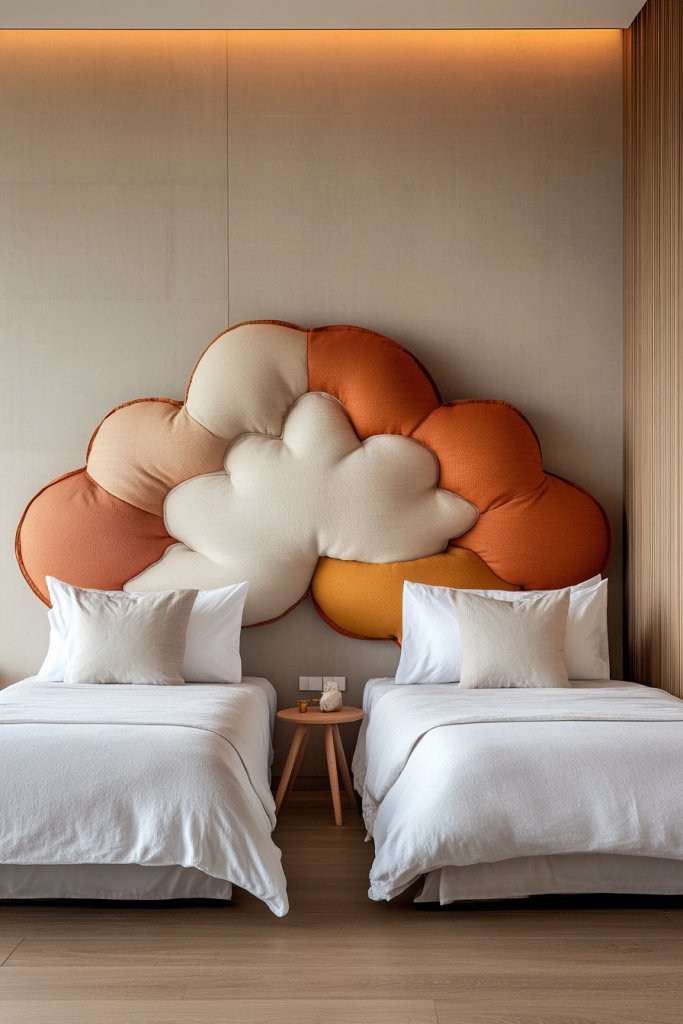
Boring, plain headboards can make even the coolest bed look dull. Kids love a headboard that sparks imagination or adds a splash of color. Creative headboard ideas turn a simple bed into a statement piece that reflects personality. They’re an easy way to elevate the room’s style without a full makeover.
Recommended Products to replicate this idea
| # | Preview | Product | |
|---|---|---|---|
| 1 |
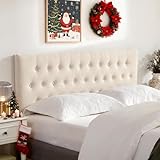
|
Huatean Home Tufted Upholstered Headboard Queen Size, Solid Wood Head Board with Durable Metal Legs,... | Check Latest Price |
| # | Preview | Product | |
|---|---|---|---|
| 1 |

|
Art3d Premade Board and Batten Paintable Wainscoting Kit, MDF Accent Wall Panel for Kitchen Bedroom... | Check Latest Price |
Imagine a headboard made from a patchwork of colorful fabric panels or painted wooden planks arranged in a fun pattern. Reclaimed wood or plywood can be painted with murals, quotes, or abstract designs for a personalized touch. Upholstered headboards with plush fabrics or textured textiles add softness and comfort. The headboard becomes a focal point, blending function and artistry, making the bed the center of attention.
Use removable fabric covers or peel-and-stick murals for easy updates. Create a DIY headboard with framed corkboards, chalkboard paint, or decorative tiles. For a more subtle approach, opt for textured wall panels or painted geometric shapes. Incorporate themes like nature, space, or favorite colors to match your decor style. These ideas work well in any room size and can be tailored for any age.
Start by choosing a headboard style that matches your room’s vibe. Measure the bed width and height, then gather materials—paint, fabric, reclaimed wood, or tiles. If upholstering, attach foam or padding before covering with fabric. For painted murals or geometric designs, prep the surface with primer and use painter’s tape for clean lines. Secure or mount the headboard firmly to the wall or bed frame. Finishing touches like decorative trim or LED backlighting can add extra flair.
Let kids pick their favorite colors, themes, or patterns for their headboard. Add personal details like initials, favorite symbols, or motifs. Incorporate tactile elements—like fabric textures or raised wood designs—for sensory interest. Regularly update or add new decorations to keep the headboard exciting. It’s a creative way to make the bed truly theirs.
A standout headboard boosts the overall vibe and confidence in a kid’s space. It shows personality and effort, making the room feel bespoke. Plus, DIY projects foster pride and creativity. Ready to craft a headboard that wows? It’s a fun, impactful project anyone can do!
13. Personal Art Displays with Washable Markers
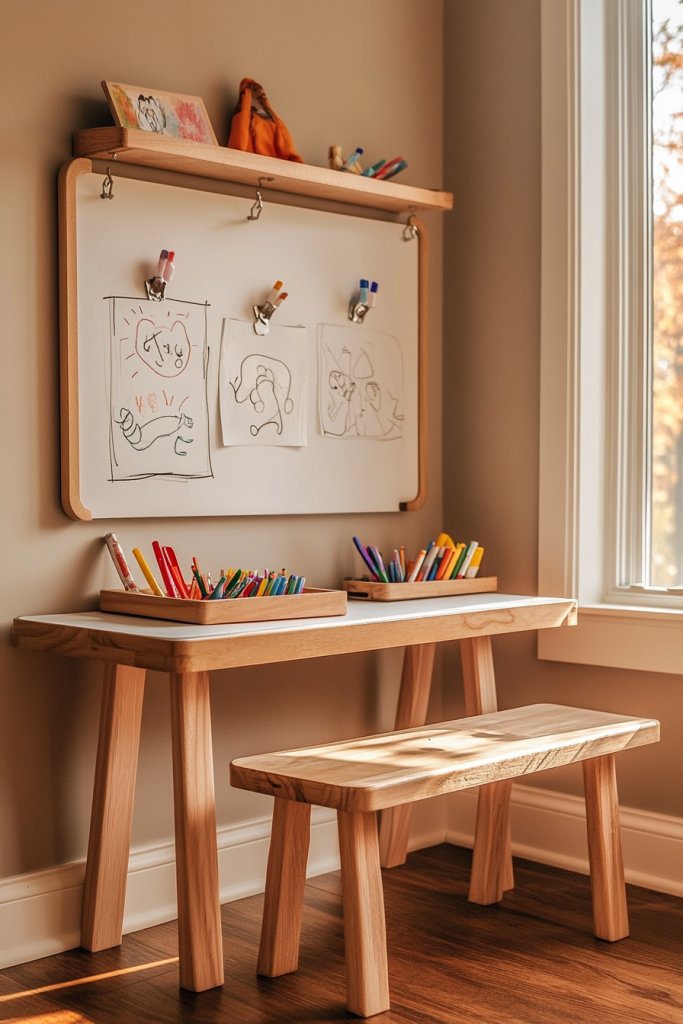
Kids love to create, but their masterpieces often end up lost or cluttered. A dedicated art display area encourages creativity while keeping the room tidy. Using washable markers and easy-to-change displays makes showcasing art simple and fun. It transforms the bedroom into a lively, inspiring space.
Picture a large corkboard or chalkboard wall painted with a vibrant color. Kids clip or pin their latest drawings, or use washable markers to doodle directly on the surface. Frames or wire cables with clips add a touch of organization and style. The space becomes a dynamic gallery, full of color and personality, where art is celebrated and easily rotated.
Use magnetic paint or chalkboard paint for versatility. Incorporate wire or string with clips for a flexible display that can be updated constantly. Add a small ledge or shelf for storing supplies or framed art. Seasonal themes or favorite characters can be rotated in to keep things fresh. This approach works well in any size room and suits all ages.
Prepare a wall or section of wall with primer, then apply chalkboard or magnetic paint. Install hooks, wires, or bulletin boards for displaying artwork. Use washable markers for doodling, and encourage kids to change their art regularly. Keep a small caddy nearby with supplies—markers, clips, and erasers—to keep the area organized. Clean the surface periodically for a fresh look and easy artwork rotation. Celebrate their creativity often to foster confidence.
Let kids choose their favorite colors for the display surface or frames. Add decorative borders, themed decals, or personalized labels. Use different textures—like fabric or paper backgrounds—to add variety. Incorporate themed accessories, like stickers or stamps, to enhance their display area. Encourage them to add captions or titles to their artwork for extra fun.
A dedicated art display boosts confidence and encourages ongoing creativity. Kids learn to take pride in their work and develop organizational skills. It makes the room more lively and personal. Ready to turn blank walls into inspiring galleries? Your kids will love having a space to showcase their talents!
14. Soft, Coordinated Window Treatments for Privacy and Light Control
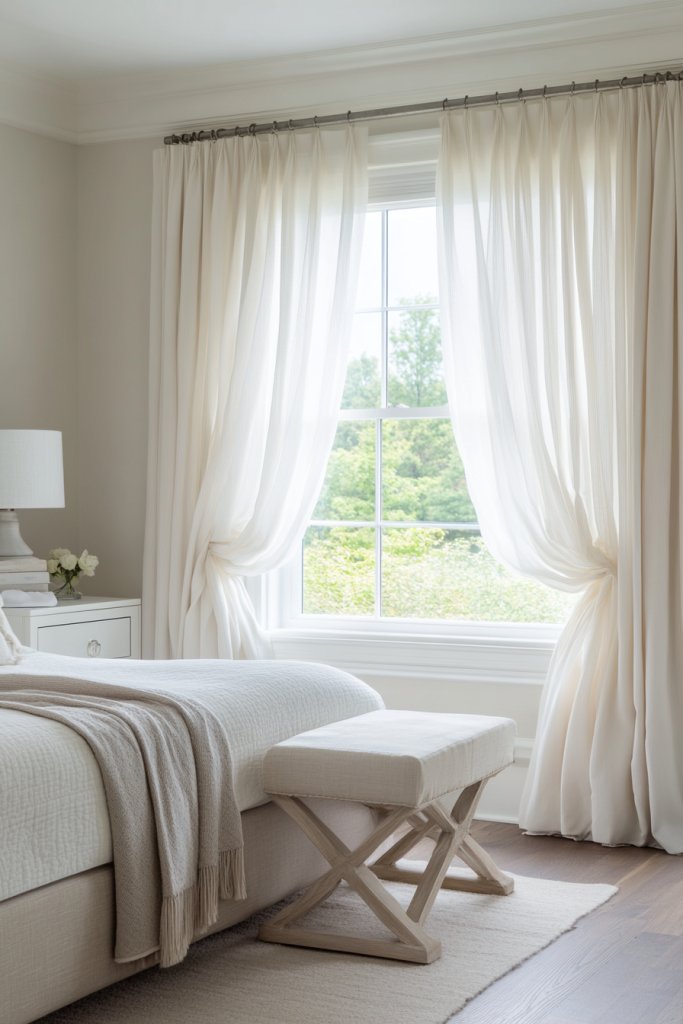
Bright sunlight or early morning glare can disrupt sleep or study time in a shared bedroom. Window treatments that are soft, coordinated, and functional help control light and add a cohesive look. They create a calm environment for rest and focus, while also offering privacy. It’s a small detail that makes a big difference.
Recommended Products to replicate this idea
| # | Preview | Product | |
|---|---|---|---|
| 1 |

|
LEMOMO Blackout Curtains 52 x 84 inches Long Black Curtains Set of 2 Panels Thermal Insulated Room... | Check Latest Price |
| # | Preview | Product | |
|---|---|---|---|
| 1 |

|
CHICOLOGY Roman Shades for Windows , Window Treatments , Roman Shades , Roman Window Shades , Room... | Check Latest Price |
Imagine flowing curtains in a gentle pastel or neutral tone that match the room’s overall palette. Layer with sheer panels for diffused light during the day and blackout curtains for nighttime darkness. The fabric’s texture adds softness and elegance, transforming the window into a design feature. Decorative tiebacks or fabric trims add personal flair, making the window a focal point that complements the room’s style.
Choose blackout or thermal curtains for better light control and insulation. Use roller blinds or Roman shades in coordinating colors for a sleek, modern look. Layer different fabrics or patterns for visual interest, or opt for subtle, monochrome tones for a minimalist vibe. For seasonal updates, swap out curtains or add decorative valances that match current decor trends.
Measure your window carefully to select the right curtain length and width. Install rods or tracks securely, ensuring they can support the weight of your chosen fabric. Attach curtain rings or hooks for easy opening and closing. Use tiebacks or decorative clips to hold curtains open during the day. Regularly wash or dry-clean fabrics to keep them fresh and free of dust. Consider blackout liners for better sleep quality.
Let kids pick their favorite colors, patterns, or textures for their window treatments. Add decorative trims, ribbons, or personalized tiebacks for a custom touch. Incorporate themed fabrics, like stars or stripes, to match their interests. Use layered styles for versatility—daytime sheer with nighttime blackout for the perfect balance. Small decorative pins or clips can add a playful element.
Coordinated window treatments improve sleep quality and room ambiance, fostering well-being. Kids feel more in control of their environment and learn to appreciate design details. It’s an easy upgrade that enhances the overall look and function of the room. Ready to elevate your room’s style and comfort? It’s easier than you think and makes a big impact!
15. Space for Shared Activities with Versatile Furniture
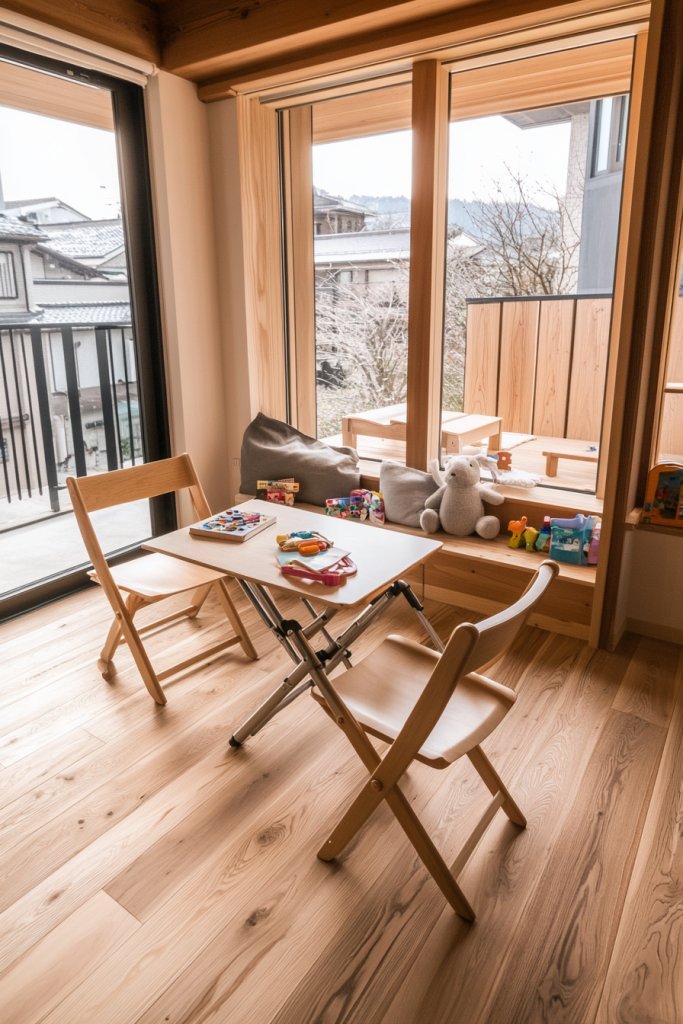
A shared bedroom can feel cramped, leaving little room for fun activities or collaborative projects. Versatile furniture creates dedicated zones for crafts, games, or reading without sacrificing space. It encourages bonding and creativity while keeping the room organized. A flexible setup transforms a cluttered space into a lively, multifunctional hub.
Recommended Products to replicate this idea
| # | Preview | Product | |
|---|---|---|---|
| 1 |

|
SONGMICS MAZIE Collection - 43 Inches Folding Storage Ottoman Bench, Ottoman Foot Rest, End of Bed... | Check Latest Price |
| # | Preview | Product | |
|---|---|---|---|
| 1 |

|
FDW 6FT Folding Table, Portable Fold-in-Half Plastic Picnic Party Table with Carrying Handle... | Check Latest Price |
Imagine a low, multi-purpose table with storage drawers underneath, surrounded by floor cushions or bean bags. Foldable or stacking furniture allows quick reconfiguration for different activities. A multi-use unit can serve as a game surface, craft station, or snack area. Bright, cheerful colors and textured fabrics make the zone inviting and lively, inspiring kids to gather and create.
Choose lightweight, foldable furniture for easy storage or movement. Incorporate versatile pieces like storage benches, convertible tables, or modular seating. Use colorful, washable fabrics for cushions and covers that match the room’s theme. Seasonal or activity-based accessories—like craft supplies or game sets—can be stored nearby for quick access. It’s all about creating a dynamic, adaptable space.
Identify a corner or section of the room suitable for activity zones. Select multi-purpose furniture that fits your space and needs. Arrange seating and tables to promote interaction and comfort. Use storage units or baskets nearby for supplies. Incorporate soft flooring or rugs to define the activity area and add tactile warmth. Regularly rotate activities and supplies to keep the space fresh and engaging.
Let kids choose their preferred colors, patterns, or themes for the activity zone. Add personalized storage bins, themed cushions, or decorative accessories. Incorporate their favorite games, craft supplies, or books within easy reach. Use removable decals or labels to organize supplies and enhance visual appeal. The goal is a space that’s fun, functional, and easy to maintain.
A dedicated activity space promotes independence and responsibility. Kids learn to care for their supplies and organize their projects. It boosts creativity and makes the room more engaging. Ready to create a lively, multifunctional zone? It’s a simple upgrade with lasting benefits!
16. Neutral Decor with Personal Accessories for Balance
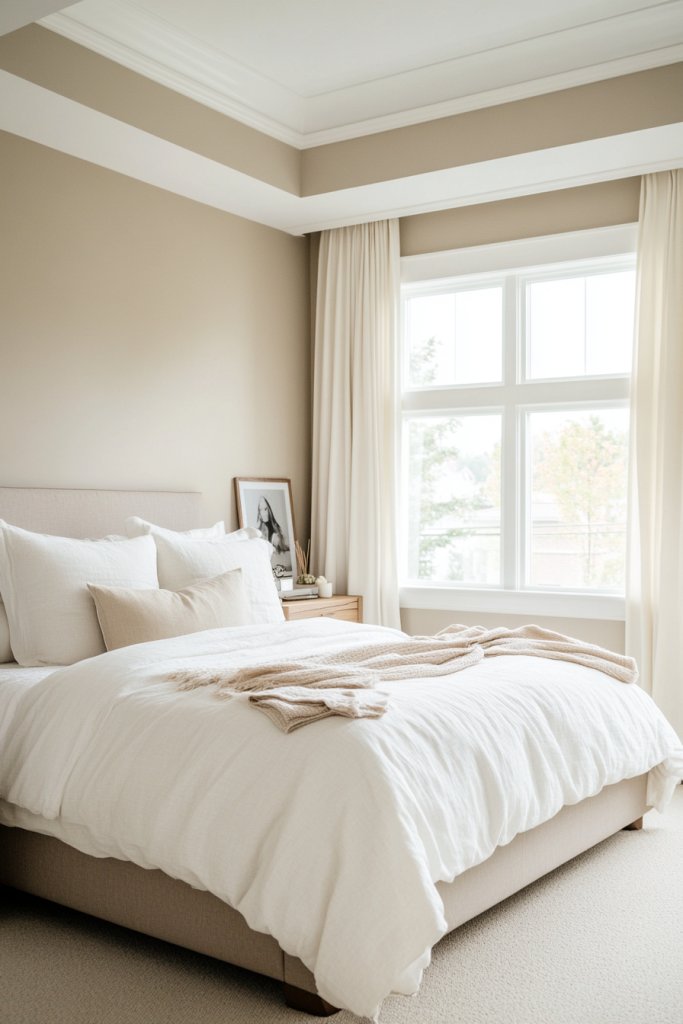
A room that’s too themed or busy can overwhelm both kids and parents. Balancing neutral decor with personal accessories creates a calming, harmonious environment. It offers a versatile backdrop that can evolve with your children’s changing tastes. The trick is to keep the overall look minimalist yet meaningful.
Recommended Products to replicate this idea
| # | Preview | Product | |
|---|---|---|---|
| 1 |

|
upsimples 10 Pack Picture Frames Collage Wall Decor for Mounting or Tabletop Display, Photo Gallery... | Check Latest Price |
| # | Preview | Product | |
|---|---|---|---|
| 1 |

|
4 Pack Large Closet Storage Baskets Bins for Shelves | Fabric Closet Organizers and Storage with... | Check Latest Price |
Picture soft, neutral-colored walls paired with simple furniture in natural finishes. Layer textures through bedding, cushions, and curtains—think linen, cotton, and wool in shades of beige or gray. Add personality with small, colorful accessories like personalized pillows, plush toys, or framed photos. The room feels serene yet lively, with subtle pops of color and personal touches that keep it warm and inviting.
Use a monochrome or analogous color palette for a sophisticated look. Incorporate natural elements like wooden frames, woven baskets, or soft textiles. Seasonal updates can include colorful throws or themed accessories without disrupting the base decor. Keep clutter minimal, and let personal items stand out as focal points. This style adapts easily as children grow or as tastes change.
Choose a neutral base for walls and furniture—think whites, beiges, or soft grays. Use simple, elegant textiles and keep accessories minimal but meaningful. Incorporate personal items like favorite plush toys or framed photos in stylish frames or containers. Avoid overloading shelves—less is more. Regularly refresh small accessories to keep the look current without a full overhaul. It’s about creating a peaceful, adaptable space.
Add personal touches through colorful cushions, personalized wall decals, or themed textiles. Use decorative storage solutions that blend seamlessly with the decor, like woven baskets or fabric bins. Incorporate heirloom or sentimental items to add character. Rotate accessories seasonally or as interests evolve, maintaining a balanced, inviting environment. It’s a timeless aesthetic that celebrates individuality within simplicity.
A balanced, neutral decor fosters calm and focus, making the space more enjoyable. Kids learn to appreciate simple, elegant design and feel more at peace. It’s an adaptable backdrop that grows with them, requiring minimal updates. Want a room that’s stylish, timeless, and easy to personalize? This approach is your answer. Enjoy a serene space that truly feels like home.
Conclusion
From playful themes to smart storage hacks and personalized decor, these shared bedroom ideas offer a variety of ways to create a harmonious and joyful space for boys and girls. Don’t hesitate to try these creative solutions in your own home—your kids will love having a room that feels just right for both of them. With a little imagination and effort, you can turn their shared space into a beautiful haven of friendship and fun!